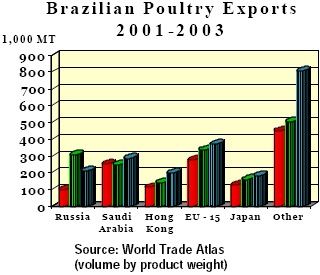



Brazilian Meat Production
By USDA, FAS - This report by the Foreign Agricultural Service looks at Brazil's recent export success, focussing on how the Brazilian Poultry Empire was built. Brazil’s export prowess in agricultural products is the result of a deliberate strategy that began in the early 1990’s. After discarding a policy of import-substituting industrialization, which for years crippled agriculture by diverting state resources into industrial development, Brazil has now fully embraced agriculture as a way to generate export revenue and encourage employment in rural areas.
![]() The meat sector in particular is regarded as an important channel for valued-added exports. Investment in the meat sector has been most noticeable in the south and southeastern regions, where there is generally greater affluence and better access to maritime infrastructure.
The meat sector in particular is regarded as an important channel for valued-added exports. Investment in the meat sector has been most noticeable in the south and southeastern regions, where there is generally greater affluence and better access to maritime infrastructure.
The States of Paraná, Santa Caterina, Rio Grande do Sul and São Paolo, which comprise less than 10 percent of Brazil’s total landmass, encompass 37 percent of the population and 51 percent of GDP; these States also account for 70 percent of poultry production, 49 percent of pork production, and 26 percent of beef production.
While the majority of Brazilian meat exports still originate from these four States, the Cerrado region, a 1.5 million square kilometer expanse located around the central plateaus of Mato Grosso, Mato Grosso do Sul, Goiás and Minas Gerais, is the new frontier for largescale agricultural development. Already well known for the production of corn and soybeans, Brazil’s Cerrado is also ideally suited for livestock and poultry production. With abundant feed supplies and
inexpensive land still relatively unencumbered by environmental regulations, the Cerrado has vast potential for meat production. Almost half of Brazil’s beef herds, which are largely grass fed zebu
breeds, are based in the Cerrado. Regional poultry production has also nearly doubled in the 6 years between 1997 and 2002.
Building the Brazilian Poultry Empire
As the world’s second largest poultry exporter, the Brazilian avian industry is highly competitive
in genetics, technology and marketing. The industry is vertically integrated, with the top four
companies dominating export trade, accounting for over half of all of Brazilian poultry exports.
Incidentally, some of the same companies, Sadia, Seara and Perdigão, are also the three
dominant pork exporters. However, unlike pork, Brazil’s poultry export markets are highly
diversified.

More than 90 countries currently buy Brazilian poultry. Poultry exports, which amount to about one-quarter of total production, are a model of Brazil’s export strategy. Brazilian President Luis Inacio Lula da Silva is often quick to note that Brazil is not content with just exporting raw material and minerals, but rather expects to expand trade in high-tech and high value-added products. Around the world, Brazilian poultry is increasingly sold in the form of high value, branded, consumer ready products. On the world market, these products have managed to remain very competitively priced, particularly as feed cost volatility in Brazil appears to have stabilized.
With the recent outbreaks of Exotic Newcastle Disease and Avian Influenza (AI) in Asia, and to a
lesser extent in the United States, Brazil has been in an advantageous position to capture market share in countries where imports of broiler meat from countries with AI have been temporarily suspended.
This has already been an important factor for Brazil’s export growth in 2004, as Asian markets like China, Japan and South Korea, make up for receding demand in the Middle East. During the first three months of 2004, Brazilian broiler and turkey shipments to Japan rose 85 percent. For
2004, total Brazilian poultry exports are expected to increase by 10 percent from 2003, to 2.225
million tons.
Further Information
To read the full report, please click here. (PDF)
Source: USDA, Foreign Agricultural Service - June 2004








